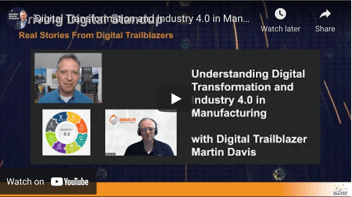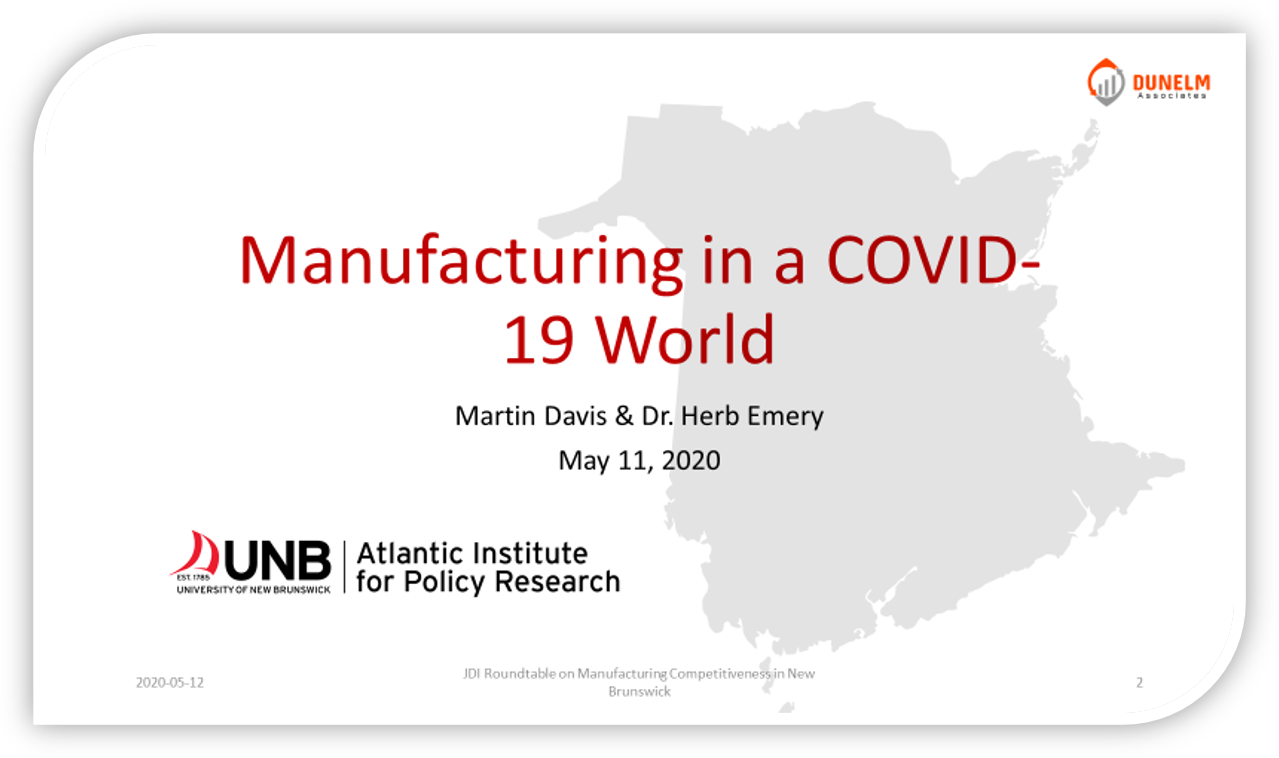Industry 4.0 - A structured approach to the future of manufacturing
Dunelm
What is the future of manufacturing?
People have argued that the future of manufacturing in North America is bleak and the trend in previous years has seen a move to lower-cost regions. As an alternative, others have argued that we need to change our approach and it’s not just about low-cost labour. Covid-19 supply chain disruption and shutdowns have further increased this focus on built locally.
So, what is the future of manufacturing?
Is it all about technology and automation?
Is it highly complicated and expensive?
This article is based on a recent webinar we conducted for the Excellence in Manufacturing Consortium, it explores these aspects, takes a back to basics view of Industry 4.0, and highlights the opportunities to start simply and build.
What is the value of industry 4.0?
Industry 4.0 originated in Germany around 2012 and was designed as a drive for manufacturing improvements to grow the German economy. Unlike some other economic development initiatives, Industry 4.0 was ground-breaking and pulled together a robust set of industry approaches that had widespread applicability and huge potential. The estimated GDP value for North America is a massive $7.1 Trillion (by 2030). See image 1 “GDP Value of Industry 4.0 by 2030 (all images are located at the end of the article).
Industry 4.0 Adoption
Recent surveys have shown that Industry 4.0 is well known, but not well understood. Even though it is 8 years old, and can add considerable value, there are limited levels of adoption with about 57% of companies in the early stages and only 30% that have extensive usage.
The explanations for the limited adoption are likely many and varied. Among manufacturers a couple of the key reasons are:
- Lack of resource
- Too busy running the day to day to try something new
- Fear of technology
Adoption is building though, and due to Covid-19 impacts and the need to operate with fewer people, the latest figures may show further improvements.
Real Benefits
As mentioned earlier, Industry 4.0 can provide considerable benefits to Industry. Studies have shown considerable productivity increases, reduced operating costs, and improved product quality. Some companies are also reporting improvements in their ability to innovate. See image 2 Real Benefits from Industry 4.0.
What is Industry 4.0?
Described as the 4th Industrial Revolution the official definition is “the merging of cyber and physical systems”. People immediately assume it is about technology, robots, and automation. While those are all potential aspects, so are sensors, connectivity, the Internet of Things (IoT), and safety.
Fundamentally, at its core, it is about turning real-time data from your equipment into information to make decisions and drive improved processes, be those manual or automated.
What is IoT / IIoT?
No discussion on Industry 4.0 would be complete without mention of IoT and IIoT (Industrial Internet of Things).
What is IoT and how does it relate to Industry 4.0? IoT is about intelligent internet-connected devices and equipment such as digital thermostats, light switches, video doorbells, etc, which can be controlled from anywhere.
And what about IIoT? Industrial applications of IoT based on similar internet-based technology, such as low-cost wireless sensors. The applications of IIoT are considerable and likely outweigh those of IoT in the domestic market.
Some people use the terms Industry 4.0 and IIoT interchangeably, however, strictly speaking, IIoT is simply a technology component and a subcomponent of Industry 4.0.
Sound complicated, expensive? It does not have to be scary! Our advice starts with the basics and build.
Start Simple and Build
Do you really know how your machines are being utilized? How long are they sitting idle, down for maintenance, or broken down? Start simply by collecting some basic data, use a stopwatch and clipboard if need be. Even that basic information will be an eye-opener and will help you make better decisions. See image 3 clipboard and stopwatch.
Once you have started collecting basic information manually, it’s worth exploring improved ways of gathering data, making use of tools or interfaces provided by each machine’s manufacturer, using connectivity that is available to get feeds of the data, storing that data in some form of a database or specialized industrial data historian.
It’s important to add context to the data you are collecting, without adding context you just have a string of numbers, but once you include details of the machine, date, time, the product being made, outside temperature, and other associated data you now have a fuller picture of what is going on and can start to understand the situation and the trends. This information is now more useful to help you make decisions.
If you are feeling adventurous you can then start to add more advanced tools which could include Artificial Intelligence and Machine Learning to help automate your decision making. See image 4 Build on that and Automate.
It DOESN’T HAVE TO BE COMPLEX and there are a lot of specialist industrial systems integrators out there that can help you. But there are other things to consider.
Industry 4.0 Maturity Model
Having spent several years driving Operational Intelligence and Industry 4.0, plus a lot of time researching it and discussing with people with years of experience in this field we have built a comprehensive model of what it takes to be successful.
This model is already in use by the JDI Roundtable on Manufacturing and was recently the subject of two webinars for the Excellence in Manufacturing Consortium sponsored by ACOA and the NRC.
The model identifies stages of maturity against several criteria and can be used to both measure where you are and provide ideas for the next steps. At its heart, data is the key underlying component, but several other aspects are required for you to be truly successful. See image 5 Maturity Model Summary.
Leadership & People
It starts with Governance & Strategy, do you have the right people with the necessary authority leading this, or is it being driven by one person in the plant? Do you have a strategy that clearly identifies your goals and approach, or is it random activities that seem like they will give you benefit? Do you have a plan to deliver value, prove it out in small pilots then repeat it and scale it?
Do you have the right skills and talent, either internally or through external help?
Have you considered Change Management and the impact these types of changes will have on your people? Getting your staff involved as early as possible reduces resistance, but more importantly, the people doing the work can give you a lot of good ideas on how to improve.
(For more on this see my blog on Change Management: https://martindavis01.wordpress.com/change-management/)
Data & Information
At its core Industry 4.0 is about data, how you collect it, store it, add context to it and analyze it to make the right decisions – be those decisions made by humans or by machines. Without good data, you are back to guessing! This is where the real value comes from and as discussed earlier is the place to start.
Practical Examples:
- Collect and store key data
- Sensors & Dashboards on all key machine centers
- Remote monitoring & mobile tools to access the data
Manufacturing
When Industry 4.0 is mentioned, as well as technology, many people immediately think about cool automation and advanced robotics that will make their plant sing! These are important and aspirational aspects of Industry 4.0, but so are other areas, such as maintenance, where moving from scheduled to condition-based, to predictive and finally prescriptive maintenance has the potential to deliver considerable savings in both downtime, labour, and parts.
We should not ignore aspects of safety that can be improved by using Industry 4.0 and IIoT type approaches and has the potential to save both lives and costs.
Practical Examples:
- Condition Based Maintenance (automated)
- Predictive Maintenance using analytics or more advanced using Artificial Intelligence
- Asset Tracking & Management
- Personnel Safety / Collision Avoidance
- Robotics and Autonomous Vehicles
- Autonomous Factories
Operational Excellence
No discussion on manufacturing improvement can be complete without mention of OEE (Overall Equipment Efficiency) and its component parts. This metric should be one of your key KPIs and coupled with techniques such as Process Improvement, Lean, and 6-Sigma will help drive improved performance.
Practical Examples:
- OEE by machine center
- Real-time Quality Detection
Supply Chain
An area often neglected when discussing Industry 4.0 is the Supply Chain. While only the most advanced companies are likely to consider Just-In-Time (JIT) for parts or raw materials, all companies need to be aware of their upstream (raw materials) & downstream (finished goods) supply chain. This data will assist them with their production planning and optimization. This is especially important with the impacts of Covid-19 & the growing driver shortages in North America.
Practical Examples:
- Real-time Freight tracking
Technology
The last category within the Industry 4.0 Maturity Model is the one most often talked about, Technology. The opportunities from the latest technology to have everything connected and utilize low-cost wireless IIoT sensors to provide data from anywhere, including legacy, remote or mobile equipment, is tremendous.
However, technology on its own will not solve your problems, it needs to part of a bigger strategic approach that includes all aspects of this model.
There are also more advanced opportunities available, such as the use of Augmented Reality (e.g. remote assistance) or Virtual Reality (e.g. simulating part of the line and allowing options to be explored).
Practical Examples:
- IIoT devices
- Low-cost wireless sensors
- Digital Work Instructions / Augmented Reality
Summary of Industry 4.0 Examples. See image 6 practical examples.
Competitive Advantage
At its heart Industry, 4.0 is a philosophy or a corporate strategy and is about how you use data to drive a smart or digital factory, how you empower your workers with data and use techniques such as process improvement to improve performance. This is supported by various enabling technologies, connected devices, and analytical tools.
The end results? Improved performance, higher OEE, and reduced downtime, which deliver increased revenue and profitability. See image 7 Industry 4.0 + Industrial Internet = Competitive Advantage.
For further information, review the links below:
DUNELM website: https://dunelmassociates.com/
Read the original article here
.png?width=600&height=187&name=Untitled%20design%20(2).png)


